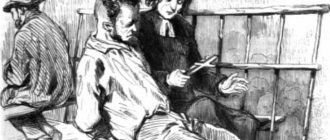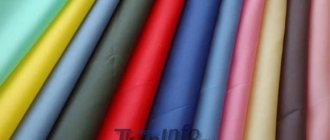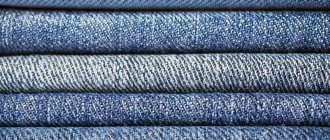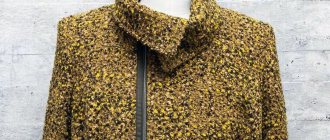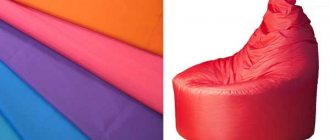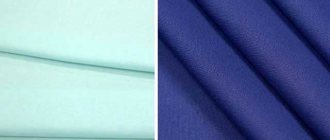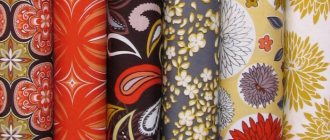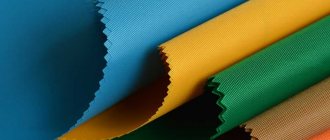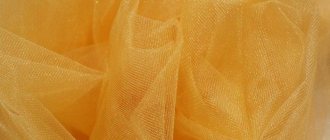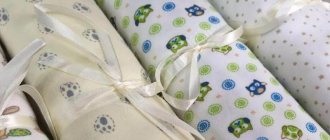Classification by composition
How a new product will look and its quality are determined by the structure of the fabric, namely the composition of the fibers. Natural, synthetic and mixed fabrics for clothing are used as raw materials for creating models. Each type has its own classification of fabrics.
In the first case, the products are of plant and animal origin. In the second option, the fabric is obtained by processing oil and coal. Finally, mixed fibers are a combination of several groups of fibers. In the production of clothing, a combination of types of fabrics is carried out in order to find the best solution and obtain a new type of product that will have all the positive qualities of all types of materials at once. In order to correctly select fabrics for sewing a fashion model, their characteristics, positive and negative aspects must be taken into account.
Natural
They represent the most valuable material. Natural fabric does not irritate a person’s skin, allows him to breathe, and does not cause diseases. Due to their safety, such fabrics are used to produce clothes for newborns and small children, bedding and underwear.
In clothes made from natural fabrics there is no place for synthetic and other artificial additives. The product is environmentally friendly and has positive properties. There are main groups of natural fabrics:
- Silk - light, durable and elastic materials (silk, dupont, satin, crepe);
- Cotton - soft, environmentally friendly, wear-resistant, easily combined with other groups of fabrics (velor, corduroy, denim, satin, jacquard);
- Wool - during production, animal wool is taken: sheep, goat, camel. The result is felt, cashmere, batting, drape, felt;
- Linen - have good thermal conductivity and wear resistance (linen, burlap, fine linen).
In the production of natural fabrics for clothing, chemical and synthetic components are not used, so the products are highly environmentally friendly and suitable for people suffering from skin and respiratory diseases.
Silk
Cotton
Woolen
Linen
Synthetic
Such fabrics are produced chemically, the raw materials for which are oil, gas and coal. Synthetic materials are suitable for sewing protective clothing, which is used in emergency situations, as well as for creating sports uniforms. Compared to natural fabrics, synthetics have their pros and cons.
Advantages of synthetic products:
- Long service life. Artificial materials have improved wear resistance; they are not exposed to harmful bacteria, mold and mildew. High-tech processing of fibers during the production process with subsequent dyeing of the fabric provides it with a durable color for a long operational period;
- Light weight material. Synthetic clothing is lightweight, water-repellent and dries instantly. Due to high demand from buyers and the low cost of raw materials, clothing production volumes are increasing, reducing the final cost of the product.
The disadvantages of synthetics include:
- May negatively affect human health – people suffering from skin diseases may experience allergies;
- The material is highly electrified;
- Poorly absorbs moisture and allows air to pass through, reducing the hygienic characteristics of the fabric.
Recently, types of clothing with a metallic sheen have become popular in the fashion world. The effect is achieved by applying a film of real metal or alloy to the surface of the product using a high-tech method. Previously, metallized fabric was used as reflective coatings for uniforms.
Mixed
Mixed products are a combination of natural and synthetic components in different proportions. The result is a strong, reliable and comfortable fabric. Clothes made from mixed materials do not wrinkle, retain their shape, do not fade and are pleasant to the touch. The surface of the fabric is sometimes coated with water-repellent impregnation.
Combined fabric is widely used in the creation of industrial designs of work suits. It is noteworthy that ready-made clothing patterns are also stitched with threads that contain natural and synthetic fibers.
The method for producing blended fabric is to mix dissimilar fibers at the initial spinning stage. The finished canvas looks the same on both sides.
The largest manufacturer of women's, men's and children's clothing made from mixed fabrics in the post-Soviet space is the Tekhnotkan brand, Kyrgyzstan. The clothing samples are made with high quality and style; the models feature expensive fittings, guipure and leather inserts.
To
Cloquet: A two-layer crepe fabric with a “bubble” surface. During the finishing process, the bottom layer of fabric contracts and the top layer forms uneven swellings. Cloquet cannot be ironed.
Leather: made from natural animal skins. There is a distinction between nappa leather (kid leather) with a smooth surface and velor leather with a fleecy surface.
Understanding leather materials
Crepe: a collective name for fabrics with a grainy, knotty surface acquired through crepe twisting of yarn, interlacing of threads, or embossing on the fabric. Pleated Crepe: An artificial crepe with a bark-like surface.
Crepe de Chine: a fine plain weave fabric made from crepe twist yarn with a grainy surface.
Crinkle, crash: crinkled fabrics. The folds are often wrinkled in the lobar direction and are more or less pronounced.
Lace: There are many varieties of lace - embroidered (Plauen), woven (machine), bobbin (Valenciennes) or crocheted (basson).
Crash effect!
Types depending on the type of clothing
Modern brands specializing in the production of fashionable clothing present such a huge number of fabrics that it is difficult to stop and choose a specific item. The comfort and convenience of clothing is ensured by the material from which the product is made. For example, for home clothes, a flannel jacket and flannel are more appropriate. In hot weather, it is convenient to wear light clothes made of thin knitwear or chintz. For outerwear in cool weather, you should choose warm drape or rateen. In spring or autumn during the rainy season, the best companion would be a raincoat or waterproof fabric. There are a large number of names of fabrics, and in order to know whether a fabric is suitable, you need to be guided by its characteristics.
Upper
As soon as the first signs of cold weather arrive, the wardrobe begins to be replenished with jackets, down jackets and raincoats. Cashmere, cloth, wool, suede, leather and drape are used to create warm jackets and coats. Raincoats, denim and nylon are an integral part of windbreakers. Fur coats are a rich combination of leather and natural or artificial fur.
The main list of names of fabrics used in sewing outerwear:
- Cashmere is a lightweight, warm fabric made from pure wool, made by a special method of weaving fibers - practical and comfortable;
- Gabardine is a wear-resistant woolen fabric;
- Suede – has a waterproof velvet surface. This is a thin, soft and pleasant to the touch type of leather;
- Eco-leather is a durable material on a cotton basis, the pattern on the surface is made by embossing and resembles natural leather;
- Nylon is a synthetic material that has high strength and resistance to deformation;
- Corduroy – a cotton base with a velvety ribbed texture;
- Velor is a soft and dense material, depending on the quality of the fibers that predominate in the fabrics, it can be cotton, wool and synthetic;
- Drape – woolen fabric with a smooth surface;
- Cloth is a material made of wool with a pile coating, does not get wet and protects in windy weather;
- Quilted fabric - two types of fabrics, stitched together, and inside there is insulation in the form of cotton wool, silicone, padding polyester or batting. The name quilted fabric comes from old England, where the patchwork technique used to flourish;
- Jeans - cotton yarn with the addition of lycra provides durability and versatility of the models. Denim items fit almost any type of wardrobe;
- Raincoat - the basis of the fabric is made up of mixed fibers of cotton fabric, suitable for use in any weather;
- Jacquard fabrics are fabrics in which natural and artificial fibers are intertwined in such a way that a relief pattern is obtained. Clothing made from jacquard is capricious and requires increased attention;
- Faux suede is soft and comfortable, microfiber fabric has increased strength.
Suede
Cashmere
Drape
Velveteen
Raincoat
Quilted
Jeans
Summer
In hot summer weather, you will need light, comfortable clothing that can protect you from overheating and will not hamper your movement. The material should absorb moisture, dry quickly and ventilate the air. Clothes will have to be washed a lot, so the fabric needs to be selected so that after several rinses, it will not lose color.
What fibers are summer fabric made from?
- Hemp uses the stem of the plant, which is processed and converted into thread. It has a durable structure, does not accumulate static electricity, does not wrinkle;
- Flax is an environmentally friendly product. The resulting fabric is not electrified and allows air to pass through well;
- Chinese nettle (Ramy) – the fibers are soft, breathable, and do not rot;
- Cotton – absorbs moisture, wrinkles, takes a long time to dry, and is the most suitable material for hot summers;
- Silk – has a long service life, does not lose shape, the fibers are strong and shiny;
- Wool is a warm material obtained from the hair of domestic animals. For summer collections, the finest fiber is used;
- Lightweight denim clothing is suitable for creating summer collections for women and men.
When sewing light items with large patterns, you should avoid adding small details to the look. This combination will only spoil the beauty of expensive material.
Rami
Cotton
Hemp
Demi-season
This type of clothing is considered the most important in the wardrobe of people who live in places with a variable climate and a long autumn-spring period. The demi-season fabric option is knitted fabric. It is comfortable to wear, pleasant and soft to the touch. The material will protect from strong cold winds and unpleasant dampness. It is convenient to use in winter too.
Types and brief description of fabrics:
- Pile - has a short pile on the front side, consisting of vertical threads. The advantage of a pile covering is its ability to retain heat on the harshest winter days. The structure of the fabric is strong and durable. Widely used in both casual wear and festive attire;
- Double-sided – looks the same on both sides (wool, drape, cashmere). If the fabric is frayed in some place, it can be re-faced. The price of the fabric is significantly higher than other types, but it retains heat well and is impenetrable to wind;
- Textile – the fibers of the fabric are arranged perpendicularly, forming a strong but not dense structure, and therefore provides little protection from the wind. Without lining, things will be cold and uncomfortable.
When choosing demi-season fabric, you need to pay attention to soft and water-repellent options. The canvas should not be too thick and dense.
Textile
Pile
Double sided
Sports
To achieve excellent results in sports, the athlete's form plays a special role. It should be comfortable and comfortable with strong seams. Sportswear should not restrict the athlete’s movements during exercise, not retain moisture, and be elastic.
The most popular material for sportswear from the list of natural fabrics is cotton, which perfectly absorbs the athlete’s sweat, ensuring an unhindered supply of oxygen to the skin, without causing irritation to the skin. The disadvantage of the material is considered to be low elasticity, so elastane is included in the composition of cotton fabric, which allows the clothes to fit the athlete’s figure. Natural fabrics alone cannot be used in sports, and to improve the wear resistance of clothing, synthetic material, primarily polyester, is added. There are other materials:
- Diving is a mixed fabric with elements of viscose, elastane and polyester. Effectively removes moisture, dries instantly and can be used in other types of clothing;
- Taffeta - used as a lining for outerwear, as well as a cover for sports equipment;
- Duspo - no sports suit can be made without it. The material has a velvety appearance and is additionally treated with polyurethane impregnation;
- Dazel is a knitted fabric designed to create sports options for intensive physical education;
- Mesh is the same knitwear, only there are pores in the structure of the material. Widely used in sportswear and travel clothing as a lining.
Fabrics used to create sportswear models must meet the following requirements:
- Long service life;
- Hygiene;
- Elasticity;
- Air permeability;
- Providing comfort.
Knitted sportswear can consist of natural and synthetic fibers. The fabric is widely used when sewing leggings and leggings that fit the human figure. The positive or negative aspects of any matter directly depend on its structure and properties.
The main advantages of sportswear fabrics:
- Provides moisture passage through itself and dries quickly;
- Retains its shape when worn and after washing;
- Long term of continuous operation;
- Does not form snags;
- Does not require scrupulous care.
When creating sports models, a special mesh is used, which forms an air gap and provides ventilation. Polyester combined with cotton is ideal for sewing sportswear. The surface of such products repels water and dirt, things retain their original appearance for a long time and do not shrink when washed.
Diving
Duspo
Net
Taffeta
Tourist
For long trips and hikes, you need wear-resistant, comfortable and functional clothing. The fabric should not only wick away moisture, but also block ultraviolet rays from the sun. Cotton and polypropylene are what you need. The combination of the two materials is convenient for use in arid areas and deserts. The fact is that cotton quickly absorbs moisture, and once wet, after a while it will begin to cool, losing almost all of its insulating abilities. This is where cotton begins to intensively absorb heat, so it is not recommended to use a cotton product in winter. And in the hot desert, this is the best choice.
Polypropylene, unlike cotton, does not absorb, but rather allows moisture and sweat to pass through and dries instantly. This material is used as the main layer when sewing tourist clothing. It is easy to wear, soft, and inexpensive. There are several disadvantages of the material:
- Formation of an unpleasant odor when worn continuously;
- It is not recommended for use in high ambient temperatures, such as near an open fire. Propylene is a man-made synthetic material and can melt under extreme heat.
Polyester is the next material used when sewing variants of tourist clothing. What is polyester? The material is a synthetic product that can absorb large amounts of moisture. Fabric fibers are excellent heat insulators; they are woven into other fabrics and ensure the product’s resistance to stress. The fabric comes in a variety of vibrant colors, making the tracksuit more visible.
Polypropylene
Cotton
Polyester
Children's
This type of clothing requires special attention when creating it. The products are based on natural fabrics that are light, elastic and safe. The following are in particular demand:
- Chintz is a type of cotton. This material is used to make sets for newborns and small children, as well as bedding and underwear;
- Baptiste is a leader in the creation of dresses, translucent blouses and bedding;
- Flannel - products for babies cannot do without it: rompers, vests and diapers;
- Fleece is an indispensable material for baby diapers.
Recently, when sewing children's clothing, they began to use neoprene - an artificial material that has a high degree of resistance to mechanical and chemical influences. It is waterproof, repels dust and dirt, wears well and keeps its shape.
Knitted fabric is another representative involved in the creation of children's clothing. It is endowed with increased thermal insulation properties, does not shrink and allows the child to move freely, which is important.
There are a large number of fabrics for children's clothing - footer, interlock, pekhorka and many others. Which of this variety of fabrics is better cannot be answered unequivocally. The determination of the source material in the creation of children's clothing fabrics depends on the purpose of the child's clothing, taking into account many factors.
Chintz
Bike
Flannel
Batiste
G
Gabardine: dense fabric made of cotton, wool or chemical fibers with a pronounced small diagonal rib on the front side, always running from left to right, from bottom to top. The rib gives gabardine a striped fabric effect.
Glencheck: fabric with a pattern of overlapping checks. The cells may differ in color or be tone-on-tone.
Tapestry: A variegated patterned fabric in muted colors with vague transitions from one color to another.
1 - gabardine; 2 - glenchek
Rating of the best
All fabrics are good in their own way, each is endowed with advantages that others do not have. In the fashion world, three types of best fabrics for clothing have been identified, which are worthy leaders among the rest:
- First on the list is cashmere, a delicate and presentable material widely used in the creation of outerwear models. The advantages of the material are strength and thermal insulation properties;
- Next on the list is woolen fabric - tweed. Inferior to cashmere in appearance, it does not seem too rich and expensive;
- Raincoat firmly occupies the third stage - the appearance is quite simple, but the protective properties are excellent. She is not afraid of adverse weather conditions: wind, rain, dirt. And she is not afraid of the cold if she has good insulation.
Each buyer has the right to choose the material himself and put it in a leading position. Whether it will be clothes made from natural fabrics or unusual items made from synthetics - it all depends on the person’s taste and predisposition to the way he or she dresses. It is difficult to remember all the names of fabrics for clothing production, but their characteristics can be easily found in the catalogs of specialized online stores.
d
Reversible Fabric: A collective name for fabrics that have two different facing sides.
Denim: Denim fabric in which only the warp thread is dyed. The weft thread is white. Thanks to this weave, the front side is most often blue or black, and the back side is white.
Jersey: A collective name for a variety of knitted materials, from lightweight cotton to thick wool jersey.
Rules for working with knitted fabrics and thin jersey
Denim: The fabrics are predominantly cotton, often with a slight nap. Pre-washed to provide the signature slightly worn look of denim.
3 - denim; 4 - corduroy
Drape: soft, voluminous fabrics with long pile.
Duvetin: the so-called false velvet is a satin weave fabric made of cotton or viscose with thickened weft threads. After dyeing, the fabric is combed and it becomes rough.
Duchess: dense fabric made of silk or chemical fibers with a satin surface.
Blood.
Blood is a very special type of connective tissue; some histologists even distinguish it as a separate type. The blood of vertebrates consists of liquid plasma and formed elements: red blood cells, or erythrocytes, containing hemoglobin; a variety of white cells, or leukocytes (neutrophils, eosinophils, basophils, lymphocytes and monocytes), and blood platelets, or platelets. In mammals, mature red blood cells entering the bloodstream do not contain nuclei; in all other vertebrates (fish, amphibians, reptiles and birds), mature functioning red blood cells contain a nucleus. Leukocytes are divided into two groups - granular (granulocytes) and non-granular (agranulocytes) - depending on the presence or absence of granules in their cytoplasm; in addition, they are easy to differentiate using staining with a special mixture of dyes: with this staining, eosinophil granules acquire a bright pink color, the cytoplasm of monocytes and lymphocytes - a bluish tint, basophil granules - a purple tint, neutrophil granules - a faint purple tint. In the bloodstream, cells are surrounded by a clear liquid (plasma) in which various substances are dissolved. Blood delivers oxygen to tissues, removes carbon dioxide and metabolic products from them, and transports nutrients and secretion products, such as hormones, from one part of the body to another. see also
BLOOD.
T
Taffeta: fabric made from natural silk or chemical fibers. Rigidity is acquired as a result of chemical treatment, so taffeta wrinkles a lot.
Fashionable gloss. Taffeta
Tweed: A fabric made from coarse, knotted wool yarn that has a hand-finished appearance. Warp and weft often come in different colors.
Tweed - conservatism that is always in trend
Thermovelour: fluffy fabric with double-sided pile, very warm, breathable.
Herringbone Fabric: A twill weave fabric with distinct diagonal stripes.
Houndstooth Fabric: A gingham fabric with typical scalloped corners.
Rib Knit: Stretch material with alternating knit and purl stitches.
Knitwear with brushed/terry backing: fabric made of cotton or a mixture of cotton and other fibers.
Tulle: A sheer mesh fabric, often with a honeycomb structure.
7 - jacquard; 8 - “chicken foot”; 9 - “herringbone”
Epithelial tissue.
The epithelium may consist of very flat (scaly), cubic or cylindrical cells. Sometimes it is multi-layered, i.e. consisting of several layers of cells; such epithelium forms, for example, the outer layer of human skin. In other parts of the body, for example in the gastrointestinal tract, the epithelium is single-layered, i.e. all its cells are connected to the underlying basement membrane. In some cases, a single-layer epithelium may appear stratified: if the long axes of its cells are not parallel to each other, then the cells appear to be at different levels, although in fact they lie on the same basement membrane. Such epithelium is called multirow. The free edge of epithelial cells is covered with cilia, i.e. thin hair-like outgrowths of protoplasm (such ciliated epithelium lines, for example, the trachea), or ends with a “brush border” (epithelium lining the small intestine); this border consists of ultramicroscopic finger-like projections (so-called microvilli) on the surface of the cell. In addition to its protective functions, the epithelium serves as a living membrane through which gases and dissolved substances are absorbed by cells and released to the outside. In addition, the epithelium forms specialized structures, such as glands, that produce substances necessary for the body. Sometimes secretory cells are scattered among other epithelial cells; examples include mucus-producing goblet cells in the superficial layer of skin in fish or in the lining of the intestines in mammals.
m
Matlasse: double fabric with a relief, as if “quilted” pattern.
Terry: A soft, voluminous fabric made from looped yarn.
Wet Silk: Silk fabric that, after washing and rubbing, has developed a slightly fluffy "peach" surface. Wet silk is never washed, but sent to dry cleaning.
Moire: rep weave fabric with thin warp threads. It has a wavy pattern, which is applied during embossing (calendering).
Muslin: A lightweight, loosely woven plain weave fabric, primarily cotton or wool.
Wool group
The range of this group includes fabrics made from animal wool. Materials containing 100% natural raw materials are considered pure wool, but additions of other fibers and threads are allowed no more than 5%. Fabric production is carried out from sheep, goat and camel wool.
The main property of wool fabrics is the ability to retain heat. The disadvantages are increased dust holding capacity, accumulation of static electricity, difficulties in cutting and sewing products, and high maintenance requirements.
The main classification of wool fabrics is carried out according to the type of yarn used and the manufacturing method. Wool materials are divided into the following main types:
- Worsted. Made from combed yarn. The weave pattern is open. This is a fairly thin fabric made using plain, twill, crepe, and jacquard weaves. The worsted group is divided into three subgroups: dress (crepes), suit (cheviots, tights, bostons, crepes) and coats (gabardines, cover coats).
- Fine cloth. The fabric is produced from machine-made fine yarn. This is a fabric with a pile that covers the weave pattern. Plain, twill, finely patterned and multi-layer weaves are used. This subgroup includes dress, suit and coat fabrics (drapes, cloth). Popularly, thin-woven materials are called ribbed fabric. The density of the fabric makes draping and cutting difficult.
- Rough cloth. Made from thick hardware yarn. Most often it is loose, dense and rough fabric. Used for sewing workwear.
Tissur presents fabrics with a shanzhan effect made from 100% silk from the companies Belinac, Taroni
Silk
The raw materials for this material are silkworm cocoons. First, the cocoon is treated with steam or hot water, then the silk threads are carefully unwound.
Silk shantung
Shantung, or chesucha, is the name given to the material for which the raw material is “wild” silk, which is extracted from the fibers of the oak silkworm cocoon. The fabric is rough to the touch with a soft shine.
Chiffon
Translucent, airy fabric with a sandy structure. It was first invented in China, where it was made from silk.
Nervous tissue.
Nervous tissue consists of highly specialized cells - neurons, concentrated mainly in the gray matter of the brain and spinal cord. The long process of a neuron (axon) extends long distances from the place where the nerve cell body containing the nucleus is located. The axons of many neurons form bundles that we call nerves. Dendrites also extend from neurons - shorter processes, usually numerous and branched. Many axons are covered with a special myelin sheath, which consists of Schwann cells containing fat-like material. Adjacent Schwann cells are separated by small gaps called nodes of Ranvier; they form characteristic grooves on the axon. Nerve tissue is surrounded by a special type of supporting tissue known as neuroglia.
P
Palette: fabric or knitted material with sewn sparkling metal plates.
Panvelvet: A very shiny, pressed pile velvet fabric.
Papillon: finely ribbed wool poplin.
Pepita: fabric in a small light-dark check.
Pique: A fabric with a raised pattern, reminiscent of machine stitching.
Heavy Taffeta: A medium weight plain weave cotton fabric.
Lining Twill: A double-faced fabric in which one side is crepe, matte, and the other is shiny, smooth.
Poplin: A grosgrain weave made from very fine warp threads and thicker weft threads.
Polyester - what kind of fabric?
